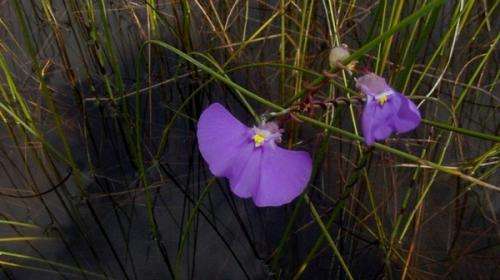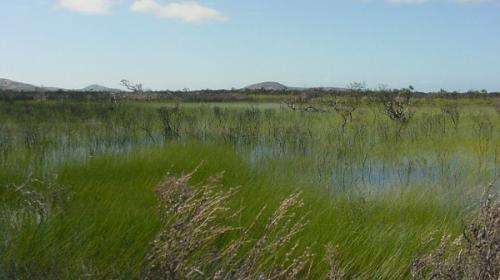Meat-eating plants stay the same on dining habits

The manner in which a local carnivorous plant known as bladderworts (Utricularia volubilis) captures their meal does not influence the type of trapped algae and prey they consume, which is a method different to some other members of the Utricularia family, research has found.
Recent research by Polish scientists, involving WA carnivorous plant expert Allen Lowrie, examined algae and prey composition in both wild and cultivated aquatic U. volubilis.
"I wanted to assess whether the construction of the trap door and trigger mechanism is important in determining the composition of captured prey by comparing with previously recorded data of some other Utricularia species," Jagiellonian University expert Magdalene Lukaszek says.
The study follows on from Ms Lukaszek's previous research on the relationship of algae and carnivorous plants in Utriculria reflexa.
"I chose to focus on Australia's U. volubilis for my Master's thesis to determine the composition of trapped organisms in plants from both their natural environment and those cultivated in the Botanic Garden at Jagiellonian University," Ms Lukaszek says.
Utricularia are commonly referred to as bladderworts due to their bladder-like traps and botanists have recorded a wide variety of trapping mechanisms across the 200 plus species.
"U. volubilis has a different trap construction to some other Utricularia species as it doesn't have trigger bristles so I wanted to observe if this influenced the composition of captured prey," Ms Lukaszek says.

Allen Lowrie sourced the wild Australian U. volubilis from wetlands near Cape Le Grand National Park near Esperance.
"Andreas Fleischamann and I collected the plants from their natural aquatic environment near Cape Le Grand and Dr Fleischamann later took them to Europe for further research," Mr Lowrie says.
Ms Lukaszek says the lab work involved dissecting the bladders and analysing the contents under a light microscope and then counting and recording the material.
The traps from the natural site in WA contained predominantly diatoms, mainly of the genus Frustulia.
Young traps from the botanic garden also contained mainly diatoms, xanthophytes and green algae, and the older cultivated traps, cyanobacteria.
The research found algae represented the dominant group of organisms found in the wild and cultivated traps and this was comparable to recorded data from some other Utricularia species.
"The study indicates that the trap construction of aquatic U. volubilis has minor influence in determining trapped organisms or phytotelmata," Ms Lukaszek says.
Provided by Science Network WA




















